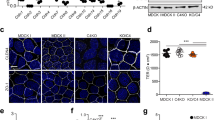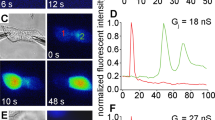Abstract
ELECTRON microscopical investigations of tight junctions (zonulae occludentes) using marker substances, have indicated that in some tissues these junctions may represent an extracellular pathway for transepithelial movement of certain small solutes1 and also restrict the movement of larger solutes2. The electrical resistance across some epithelial tissues has been used as a measure of the degree of permeability of the tight junctions to ions3, and it was suggested that junctions that are “leaky” to ions are also leaky to small non-electrolytes. Examination of tight junctions with the freeze-fracture technique has revealed the presence of a network of intramembranous fibrils4 or strands5,6. Some evidence suggests that these strands constitute the sealing component of the junction7, and Claude and Goodenough6 correlated the transepithelial permeability of a given epithelium with the number of strands in the tight junction network. Artificial methods of altering transepithelial permeability (hypertonic solutions applied to the mucosal side of the epithelium) have been used to investigate changes in transepithelial electrical resistance8, and freeze-fracture morphology9 or both10. Results from these studies do not consistently support the above correlation. An alternative approach is described here, in which the freeze-fracture technique has been used to study tight junctions of the sheep choroid plexus during foetal development. The results obtained suggest that there is no change in the ultra-structural features of tight junctions which have previously been suggested to correlate with transepithelial permeability, in spite of considerable changes in permeability during the developmental period studied11–13.
This is a preview of subscription content, access via your institution
Access options
Subscribe to this journal
Receive 51 print issues and online access
$199.00 per year
only $3.90 per issue
Buy this article
- Purchase on Springer Link
- Instant access to full article PDF
Prices may be subject to local taxes which are calculated during checkout
Similar content being viewed by others
References
Castel, M., Sahar, A., and Erlij, D., Brain Res., 67, 178–184 (1974).
Brightman, M. W., and Reese, T. S., J. Cell Biol., 40, 648–677 (1969).
Frömter, E., and Diamond, J., Nature new Biol., 235, 9–13 (1972).
Wade, J. B., and Karnovsky, M. J., J. Cell Biol., 60, 168–180 (1974).
Hull, B. E., and Staehelin, L. A., J. Cell Biol., 68, 688–704 (1976).
Claude, P., and Goodenough, D. A., J. Cell Biol., 58, 390–400 (1973).
Friend, D. S., and Gilula, N. B., J. Cell Biol., 53, 758–776 (1972).
Ussing, H. H., and Windhager, E. E., Acta physiol. scand., 61, 484–504 (1964).
Wade, J. B., and Karnovsky, M. J., J. Cell Biol., 62, 344–350 (1974).
Martinez-Palomo, A., and Erlij, D., Proc. natn. Acad. Sci. U. S. A., 72, 4487–4491 (1975).
Bradbury, M. W. B., et al., J. Physiol., Lond., 227, 591–610 (1972).
Evans, C. A. N., Ryenolds, J. M., Reynolds, M. L., Saunders, N. R., and Segal, M. B., J. Physiol., Lond., 238, 371–386 (1974).
Dziegielewska, K. M., et al., J. Physiol., Lond., 258, 86–87p (1976).
Möllgård, K., and Saunders, N. R., J. Neurocytol., 4, 453–468 (1975).
Voute, C. L., Möllgård, K., and Ussing, H. H., J. Membrane Biol., 21, 273–289 (1975).
Author information
Authors and Affiliations
Rights and permissions
About this article
Cite this article
MØLLGÅRD, K., MALINOWSKA, D. & SAUNDERS, N. Lack of correlation between tight junction morphology and permeability properties in developing choroid plexus. Nature 264, 293–294 (1976). https://doi.org/10.1038/264293a0
Received:
Accepted:
Issue Date:
DOI: https://doi.org/10.1038/264293a0
This article is cited by
-
Developmental changes in the transcriptome of the rat choroid plexus in relation to neuroprotection
Fluids and Barriers of the CNS (2013)
-
Function and regulation of claudins in the thick ascending limb of Henle
Pflügers Archiv - European Journal of Physiology (2009)
-
Brain endothelial cells and the glio-vascular complex
Cell and Tissue Research (2009)
-
Breakdown of the blood–brain barrier to proteins in white matter of the developing brain following systemic inflammation
Cell and Tissue Research (2005)
-
Multifunctional strands in tight junctions
Nature Reviews Molecular Cell Biology (2001)
Comments
By submitting a comment you agree to abide by our Terms and Community Guidelines. If you find something abusive or that does not comply with our terms or guidelines please flag it as inappropriate.



